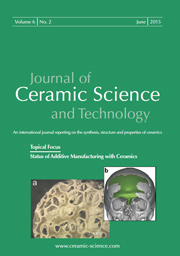Articles
All articles | Recent articles
Low-Temperature Degradation Behaviour and Mechanical Properties of a 3Y-TZP Manufactured from Detonation-Synthesized Powder
F. Kern, V. Lindner, R. Gadow
University of Stuttgart, IFKB
received May 12, 2016, received in revised form July 15, 2016, accepted August 18, 2016
Vol. 7, No. 4, Pages 313-322 DOI: 10.4416/JCST2016-00036
Abstract
In recent years, yttria-stabilized zirconia Y-TZP has attracted considerable interest in the field of dental restoration. However, the state-of-the-art Y-TZP materials made from coprecipitated powders only just comply with the current standard in terms of fracture resistance and grain size. In this study a new nanoscale starting powder produced with detonation synthesis was applied to produce a fully dense specimen by means of hot pressing in the sintering temperature range between 1250 – 1500 °C. Mechanical properties, microstructure and phase composition were studied. Low-temperature degradation behavior was quantified in an accelerated ageing test in a saturated water vapor at 134 °C. Between sintering temperatures of 1300 °C and1400 °C, the materials obtained show a combination of high strength > 1400 MPa, toughness of 6 MPa√m and fine grain size < 320 nm and thus fulfill the requirements of the dental standard EN ISO 6872. Ageing resistance was high. After nucleation of the monoclinic content, the materials exhibited zero-order growth kinetics and retained > 90 % tetragonal phase up to ageing times of 10 h ≈ 35 years in vivo.
![]() Download Full Article (PDF)
Download Full Article (PDF)
Keywords
Zirconia, mechanical properties, phase composition, microstructure, low-temperature degradation
References
1 Hannink, R.H.J., Kelly, P.M., Muddle, B.C.: Transformation toughening in zirconia-containing ceramics, J. Am. Ceram. Soc., 83, 461 – 87, (2000).
2 Kelly P.M., Rose, L.R.F.: The martensitic transformation of ceramics – its role in transformation toughening, Prog. Mater. Sci., 67, 463 – 557, (2002).
3 Li, P., Chen, I.W., Penner-Hahn, J.: Effect of dopants on zirconia stabilization – an x-ray absorption study: I, trivalent dopants, J. Am. Ceram. Soc., 77, 118 – 28, (1994).
4 Chen, M., Hallstedt, B., Gauckler, L.: Thermodynamic modeling of the ZrO2-YO1.5 system, Solid State Ionics, 170, 255 – 274, (2004).
5 Ruiz, L., Readey, M.J.: Effect of heat treatment on grain size, phase assemblage and mechanical properties of 3Y-TZP, J. Am. Ceram. Soc., 79, 2331 – 2340, (1996).
6 Singh, R., Gill, C., Lawson, S., Dransfield, G.P.: Sintering, microstructure and mechanical properties of commercial Y-TZPs, J. Mater. Sci., 31, 6055 – 62, (1996).
7 Burger, W., Richter, H.G., Picconi, C., Vatteroni, R., Cittadini, A., Boccalari, M.: New Y-TZP powders for medical grade zirconia, J. Mater. Sci. – Mater. M, 8, 113 – 8, (1997).
8 Ohnishi, H., Naka, H., Sekino, T., Ikuhara, Y., Niihara, K.: Mechanical properties of 2.0 – 3.5 mol% Y2O3-stabilized zirconia polycrystals fabricated by the solid phase mixing and sintering method, J. Ceram. Soc. Jpn.,116, 1270 – 1277, (2008).
9 Kern, F.: Mechanical properties and low temperature degradation resistance of 2.5Y-TZP – alumina composites, Materialy Ceramiczne/Ceramic Materials, 65, 258 – 266, (2013).
10 Schubert, H., Frey, F.: Stability of Y-TZP during hydrothermal treatment: neutron experiments and stability considerations, J. Eur. Ceram. Soc., 25, 1597 – 602, (2005).
11 Chevalier, J., Gremillard, L., Virkar, A.V., Clarke, D.R.: The tetragonal-monoclinic transformation in zirconia: lessons learned and future trends, J. Am. Ceram. Soc., 92, 1901 – 1920, (2009).
12 Chevalier, J., Gremillard, L. Deville, S.: Low temperature degradation of zirconia and implications for biomedical implants, Annu. Rev. Mater. Res., 37, 1 – 32, (2007).
13 Chevalier, J., Drouin, J.M., Cales, B.: Low-temperature aging of Y-TZP ceramics, J. Am. Ceram. Soc., 82, 2150 – 54, (1999).
14 Gremillard, L., Chevalier, J., Epicier, T., Deville, S., Fantozzi, G.: Modeling the aging kinetics of zirconia ceramics, J. Eur. Ceram. Soc., 24, 3483 – 3489, (2004).
15 Deville, S., Gremillard, L., Chevalier, J., Fantozzi, G.: A critical comparison of methods for the determination of the aging sensitivity in biomedical grade yttria-stabilized zirconia, J. Biomed. Mater. Res. B, 72, 239 – 245, (2005).
16 Neves, N., Barros, R., Antunes, E., Calado, J., Fortunato, E., Martins, R., Ferreira, I.: Aluminum doped zinc oxide sputtering targets obtained from nanostructured powders: processing and application, J. Eur. Ceram. Soc., 32, 4381 – 4391, (2012).
17 Neves, N., Lagoa, L., Calado, J., Rego, A.M.B., Fortunato, E., Martins, R., Ferreira, I.: Al-doped ZnO nanostructured powders by emulsion detonation synthesis – improving materials for high quality sputtering targets manufacturing, J. Eur. Ceram. Soc., 34, 2325 – 38, (2014).
18 Calado, J.: Ceramic powder production with emulsion detonation synthesis, cfi/Ber. DKG, 93, [4 – 5], E32 – E34, (2016).
19 Calado, J., Innovation through detonation: designing improved ceramic composites, Ceramic Industry (online), March 1 (2016)
20 Calado, J., Dos Santos, E.: Nanocrystaline spherical ceramic oxides, process for the synthesis and use thereof, US patent 9249020 B2.
21 Toraya, H., Yoshimura, M., Somiya, S.: Calibration curve for quantitative analysis of the monoclinic-tetragonal ZrO2 system by X-ray diffraction, J. Am. Ceram. Soc., 67, C119 – C121, (1984).
22 Patterson, A.L.: The scherrer formula for X-Ray particle size determination, Phys. Rev., 56, 978 – 82, (1939).
23 Chantikul, P., Anstis, G.R., Lawn, B.R., Marshall, D.B.: A critical evaluation of indentation techniques for measuring fracture Toughness: II, strength method, J. Am. Ceram. Soc., 64, 539 – 543, (1981).
24 Niihara, K.: A fracture mechanics analysis of indentation-induced palmqvist crack in ceramics, J. Mater. Sci. Lett., 2, 221 – 223, (1983).
25 Dransmann, G.W., Steinbrech, R.W., Pajares, A., Guiberteau, F., Dominguez-Rodriguez, A., Heuer, A.: Indentation studies on Y2O3-Stabilized ZrO2: II, toughness determination from stable growth of Indentation-Induced cracks, J. Am. Ceram. Soc., 77, 1194 – 1201, (1994).
26 Benzaid, R., Chevalier, J., Saâdaoui, M., Fantozzi, G., Nawa, M., Diaz, L.A., Torrecillas, R.: Fracture toughness, strength and slow crack growth in a ceria stabilized zirconia-alumina nanocomposite for medical applications, Biomaterials, 29, 3636 – 41, (2008).
27 Kosmac, T., Wagner, R., Claussen, N.: X-Ray determination of transformation depths in ceramics containing tetragonal ZrO2, J. Am. Ceram. Soc., 64, [4], C72 – 3, (1981).
28 McMeeking, R.M., Evans, A.G.: Mechanics of Transformation-Toughening in brittle materials, J. Am. Ceram. Soc., 65, [5], 242 – 46, (1982).
29 Mendelson, M.I.: Grain size in polycrystalline ceramics, J. Am. Ceram. Soc., 52, 443 – 444, (1969).
30 Kern, F.: 2.5Y-TZP from yttria-coated pyrogenic zirconia nanopowder, J. Ceram. Sci. Tech., 1, 21 – 26, (2010).
31 Lube, T., Fett, T.: A threshold stress intensity factor at the onset of stable crack extension of knoop indentation cracks, Eng. Fract. Mech., 71, 2263 – 69, (2004).
32 Keuper, M., Eder, K., Berthold, C., Nickel, K.G.: Direct evidence for continuous linear kinetics in the low-temperature degradation of Y-TZP, Acta Biomater., 9, 4826 – 35, (2013).
33 Swain, M.V., Rose, L.R.F.: Strength limitations of transformation-toughened zirconia alloys, J. Am. Ceram. Soc., 69, 511 – 518, (1986).
34 Basu, B., Vleughels, J., Van der Biest, O.: Toughness tailoring of yttria-doped zirconia ceramics, Mat. Sci. Eng. A, 380, 215 – 221, (2004).
35 Bartholomé, J.F., Montera, I., Diaz, M., Lopez-Esteban, S., Moya J.S.: Accelerated aging in 3-mol%-yttria-stabilized tetragonal zirconia ceramics sintered in reducing conditions, J. Am. Ceram. Soc., 87, 2282 – 2285, (2004).
Copyright
Göller Verlag GmbH


